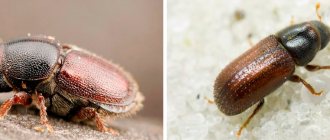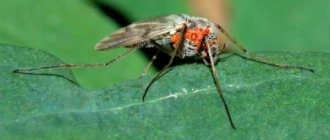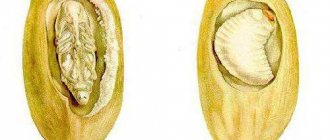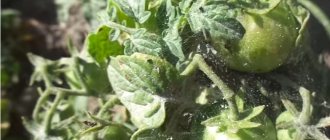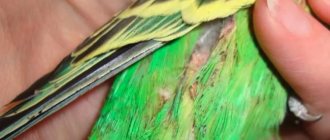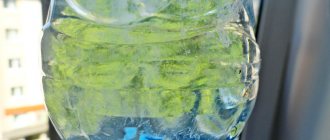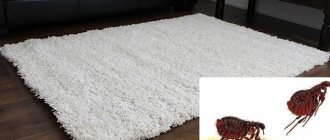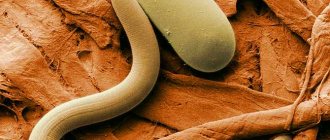Fighting mites on violets. What pests can live on violets. What they look like and what are the signs of infection. What harm is done to plants? Use of effective chemicals. Application of traditional methods. How to prevent infection.
We all know about pests that attack plants and cause great harm to flowers. When we notice that a violet begins to weaken without any reason, its leaves change color and shape, most likely a mite has settled on it. It is necessary to fight it as soon as the first symptoms of infection are noticed, since without taking any action, the pest can destroy the flower.
Next, we will find out what needs to be done if a mite appears on a violet, what chemicals and folk remedies can be used, and what preventive actions will prevent infection.
Description and appearance
Most often, the cyclamen mite appears on violets, which also affects other indoor plants. Azaleas, Kalanchoes, and cyclamen are at greatest risk of infection. But these pests harm not only indoor flowers, they also affect garden and vegetable crops. They have very small body sizes and it is simply impossible to see them on a flower without magnifying devices. They belong to the arachnids.
They have a translucent, oblong body, light yellow in color, and 8 legs. They live in buds and on young shoots. Their diet consists of plant sap. These pests multiply very quickly and within a few days after infection the colonies increase significantly.
One female lays 12 to 16 eggs daily, which require only 3-7 days to develop. A week after laying eggs, young individuals appear, which need nutrition and are ready for further reproduction. You can see what they look like in the photo.
Favorable conditions that contribute to their rapid reproduction are warmth and minimal humidity. Therefore, the peak of their activity for indoor plants occurs in winter, when apartments have heating. And for garden crops, such a favorable environment occurs in the summer, when hot and dry days arrive.
Signs of defeat
Since it is impossible to see the pest on a violet, infection can be determined from the external signs that appear on the flower. Something similar to a dusty coating appears on young shoots, buds, as well as young green leaves. The mite infestation is most noticeable on the leaves, as they change color, become dull, a yellow tint appears, then they turn brownish-gray and the leaves become deformed.
The petioles and leaves become very dry and brittle. Also, thin hairs similar to cobwebs appear on young leaves. The buds do not open and begin to fall off.
If such signs are detected, it is necessary to relocate the infected flower so that the pests do not attack neighboring flowers. You will need to immediately resort to treatment methods.
Fighting methods
There are many ways to combat this microscopic pest. You can use specialized chemicals or seek help from traditional methods.
Traditional methods
The most effective methods include bathing the violet at a certain water temperature. The procedure is as follows; at the first stage, you will need to remove severely affected leaves. Next, take a container and pour water at a temperature of 45°C into it. You will need a thermometer, since this method is effective precisely at this temperature; if it is higher, then you can harm the plant, and if it is insufficient, then the procedure will not bring any effect.
Next, you need to immerse the flower completely in water for 15 minutes. It is also necessary to maintain the correct temperature during the procedure. After the water procedure, it should be placed in a shaded place, and after a few days it can be returned to its original place.
Chemicals
As with traditional methods, a mandatory step is to remove the affected parts. Most often, acaricidal agents are used for treatment, which must be used to wipe the violet leaves. These include Akarin, Fitoverm, Aktofit, and others. Wiping is carried out every 3 days, then the time intervals are increased to 5. When the bush is very infected, they do not use wiping, but bathing, when the flower is completely immersed in the solution.
If we talk about insecticides, they are ineffective against pests. This is because ticks develop immunity to the active ingredients; in addition, the products are not capable of destroying egg laying. When carrying out treatments with acaricides, it is necessary to carry out several procedures in which the products are changed.
Antiklesch, Omite, Kleschevit, Neoron show fairly good effectiveness. But remember, treatment with these products should not be carried out in an apartment. After the procedure, the violet is covered with plastic wrap for up to 24 hours. The drugs are toxic and when using them, protective equipment must be used.
Anti-mite treatment
How to treat : everything is simple and straightforward - the plant must be thoroughly sprayed with the preparation until it is “very wet”, so that not a single untreated square millimeter of surface remains on the entire plant, and not just on the leaves. Just like that, casually spraying on the leaves “for prevention” is an empty and useless exercise. In general, treatments for preventive purposes have the same basis and meaning as drinking medicine by a healthy person in order to prevent a disease. Drug treatments are not plant vaccination; they only make sense if a pest is present.
The frequency and frequency of treatments with avermectins and any preparations in general depend on the type of pest (the time of reproduction of the pest from egg to egg, the presence of periods of non-feeding of the larvae, etc. are taken into account). In turn, the development time of the mite depends on the ambient temperature, which must also be taken into account for the correct choice of treatment schedule. The minimum period between treatments is 3 days, selected at a temperature of about 30*C, when the mite reproduces as quickly as possible. At a temperature of about 20*C, treatments can be carried out after 5 days, but their number remains the same - at least three, and it is better to do four treatments. And, of course, treatments with avermectins lose their meaning at temperatures below 18*C, at which mites stop feeding and go into diapause.
By the way, when treating with Fioverm, it is reasonable to minimize the penetration of the drug into the soil; the roots, if the drug flows abundantly into the ground, may suffer from the alcohol contained in the drug.
Security measures
When using chemicals, it is imperative to wear rubber gloves, a respirator and clothing that covers the body. During processing, containers that are used in the kitchen and when preparing food are not used.
Do not use soap in solutions, as it will significantly reduce the effect of the active ingredients. Solutions for treatment should be prepared immediately before use, and the remains should be disposed of. The procedure must be carried out outdoors; when carried out in residential premises, it can harm the health of people and animals.
After the treatment is carried out, the bushes are placed in quarantine, where they will be isolated from other plants. After 3-4 weeks, it is necessary to inspect the violet, leaves and young shoots; when there are no signs of infection, the violet can be returned to other colors.
Prevention measures
Before taking urgent measures to destroy the pest colony and save Saintpaulia from death, it is necessary to carry out preventive measures:
- immediately treat a newly purchased violet with an acaricide and quarantine it for 3 weeks - this is how much time passes from the moment of infection until the tick turns into an adult. This applies to stepchildren and cuttings. After processing, put the latter for rooting;
- maintain plants in accordance with optimal conditions;
- remove dry, old and rotting leaves and flower stalks;
- wash Saintpaulias in the shower in the heat;
- do preventive treatment with acaricides before critical seasons;
- Do not place flowers close to each other.
Advice! If it was not possible to avoid mite damage and it is necessary to save this variety, then after treating it with an acaricide, try to root the cuttings. Try to select a leaf without traces of infection. To prevent fungal diseases, treat planting material with a fungicide.
Other types of ticks
- Unfortunately, not only the cyclamen mite is dangerous for violets; plants can also infect other types of mites. One of them is a cobweb, which is no less dangerous and can lead to the death of a violet. These are small parasites that reach no more than 1 mm. In the warm season, they have a green body color, and in the fall and spring they change it to red.
- It is dangerous not only for violets; the pest affects berry and fruit crops. They also feed on plant sap. The product of their vital activity is a cobweb that envelops the flower, and it is by this that the infection can be determined. Acaricides and folk remedies are quite effective in combating it.
- Another dangerous species is the flat beetle; this mite affects violets, cacti, ficus, citrus fruits and other types of indoor plants. It has an ovoid body shape and can be yellow-orange or yellow-brown in color. When infected, the leaves begin to dry out, the plant weakens greatly and dies. Favorable conditions for reproduction are temperatures of 18-24°C, so they lay eggs all year round, which is why they pose a great danger. Acaricidal agents are used to combat them.
- Violets and root mites, as they are also called bulb mites, are not ignored. They infect plants underground; most often, orchids, gladioli, tulips, etc. are attacked by these pests. High humidity serves as favorable conditions for their reproduction. Bulbs should be stored only in dry rooms where the humidity level does not exceed 60%, which is an effective prevention.
Use of chemicals
The most lasting results can be achieved when treated with acaricides. Such drugs are contact, intestinal and systemic. The latter act as efficiently as possible. They saturate the plant from the inside, and then when they are consumed, the pathogens die.
It is optimal to use means that ensure the effective destruction of adults and eggs. They allow you to perform a one-time treatment and achieve lasting results with it. Pay attention to the hazard class. Not all products can be used indoors on indoor plants. Some of them are dangerous for animals and humans.
It is best to pay attention to products that do not have an intense odor. In gardening stores, ask for the following names:
- Sunmite;
- Mobento;
- Doni getter.
Attention! The compositions presented in this list are expensive and are not available in all stores. If you cannot find a suitable remedy, choose other drugs that show activity against ticks.
Can also be used:
- Omite;
- Alatar;
- Acarocide;
- Kleschevitis;
- Ixoder;
- Resonance;
- Sunmite.
Remember that the plant will have to be treated with intestinal and contact agents several times. To achieve maximum effect, you will have to periodically change the active component. If this is not done, mites will acquire resistance and their new generations will become resistant to the active ingredients used.
https://forum.bestflowers.ru/media/klesch-4-1.242939/full
Preventive actions
- Of course, the main preventive action is proper plant care. This includes fertilizing, watering, maintaining the correct temperature and lighting. Most often, infection occurs on bushes that are weakened and do not receive the necessary care, but healthy bushes are no less vulnerable to pests.
- To prevent difficult situations, experts recommend regularly bathing plants. This should be done at a time when there is a peak in activity, namely dry and hot weather. In addition, it is recommended to move the bushes to other places during this period so that they are not adjacent to other plants.
- Bathing is carried out as follows. The procedure can only be carried out under running water. When using a basin or bucket, pests enter the water and re-infestation occurs. While holding the bush, it is necessary to wash the lower parts of each leaf.
- You can only wipe the leaves under water with your finger; using sponges and rags will help spread the pest throughout the bush. Avoid getting water into the pot, on the flowers and in the center of the rosette. Water at a temperature of 40°C is used, but during the flowering period the temperature is reduced, the water should be slightly warm.
- Water procedures are not carried out in winter if there is no heating. When rotten leaves are visible on the plant, the procedure is not carried out. When the procedure is completed, it is necessary to remove moisture from the leaves using a regular napkin.
How to reduce the risk of parasites on violets
Be sure to keep the violet purchased (or acquired in another way) in “quarantine” for two to three weeks. If you have any suspicions about its condition, treat the plant with Fitoverm and water the substrate with Fitosporin-M once a week for a month to prevent diseases.
If you use ready-made soil for planting and replanting Saintpaulias, be sure to sterilize it first, since soil from greenhouses, greenhouses and flower beds can sometimes be contaminated. Conduct your own soil collection away from the city, somewhere in the forest. Wash and sterilize old pots well.
Do not allow a sharp decrease or increase in the temperature; the room air is too dry - moisten, do not overdry the substrate and do not flood it. Provide Saintpaulia with bright but diffused light in sufficient quantities for growth and flowering. Otherwise, your Saintpaulia will be weakened and vulnerable to parasites. Read more about the rules for caring for violets here. Small pests cause the greatest harm to violets. In this article we will talk about each insect and how to deal with it in detail.
